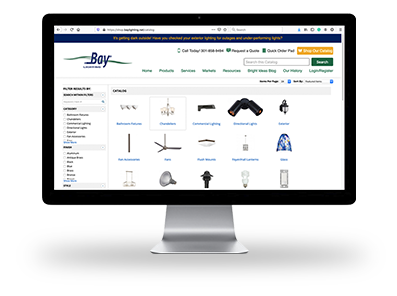Blog
- Home
- Resources
- Bright Ideas Blog
- How the Cold Weather Affects LED Lighting/Ballasts
How the Cold Weather Affects LED Lighting/Ballasts
LED vs. Traditional Lamps in Cold Weather
Some common issues arise with traditional and fluorescent bulbs regarding cold-weather performance. LEDs are overall designed to be more durable, long-lasting and efficient than other bulbs, and are generally a better choice for indoor and outdoor applications. This is especially true during the winter months when most bulbs are easily affected by drops in temperature. Read on for more on the specific differences between LED and traditional bulb performance in cold temperatures.
Efficiency
Traditional lights often take some time to warm up and switch on in the winter. This can be very inconvenient, especially in commercial settings when people need light to be able to work and function safely. Unlike traditional lighting, LEDs actually thrive in cold weather, and are just as efficient as they are in any other environmental conditions. This translates to more energy-efficient lighting, as LEDs require a lot less energy use that results in carbon emissions and higher electric bills.
LEDs don’t require a lot of power to produce light, and they provide optimal lighting for what they cost to power. Because they provide brighter lighting than traditional bulbs overall, they are the best choice for darker winter conditions.
Longer lifespan
LED technology has extended the life expectancy of bulbs and fixtures, saving commercial space owners time and money they would have otherwise spent on replacements. Cold weather tends to wear on electric and traditional bulbs, especially when they’re directly exposed to cold weather. This includes external fixtures, like streetlights, decorative, and security lighting. Their excess emission of heat causes them to burst due to the drop in temperature. LED lights aren’t subject to these problems since they don’t emit heat and withstand transitions between hot and cold.
Having to replace burnt-out bulbs with new ones, especially in a commercial space in which hundreds of bulbs and fixtures may be installed, can be costly and inconvenient. LEDs are known for their long lifespans – many have a rated life of up to 50,000 hours, which is approximately 50 times longer than a typical incandescent, 20-25 times longer than a halogen, and 8-10 times longer than a CFL. Even used 12 hours a day, an LED bulb will last more than 11 years. Upgrading your lighting to LED before the colder weather months is a smart choice that will undoubtedly save you a lot of time and money.
Mercury vapor
The biggest issue with traditional bulbs in cold weather is mercury. The lower the temperature drops, the lower the mercury vapor pressure. Therefore, there’s less mercury available to start the light. Light output is lower because the mercury does not emit the optimum amount of UV energy for the phosphor to convert to visible light. Fluorescent lights work by ionizing mercury vapor in the tube. Special ballasts and bulbs for fluorescent fixtures are available, but they can be expensive and need to be replaced more often.
On the other hand, LEDs don’t contain mercury, which in itself makes them a more durable choice for outdoor lighting. It doesn’t have any effect on life expectancy, and output is unaffected. However, it’s essential to check with your distributor regarding how low temperature is rated for just in case.
Electronic driver vs. combustible source
LED drivers are a key piece of any LED installation. Since LEDs are low-voltage, they require a power supply when connected to the high or line voltage of a commercial building or retail space. High-quality electronic drivers and cold resistance outlet wires are made to withstand low temperatures. Unlike fluorescent bulbs, LEDs don’t require a combustible source that can easily become damaged when exposed to cold weather.
LED bulbs convert about 85% of electricity into visible light, compared to only 10% for incandescent bulbs and 15% for CFL. In cold weather, the electronic driver, which causes the LED to produce light, will thrive. In fact, LED lights work best within a range of –25F and 140F, meaning they are suitable for outdoor use anywhere in the United States and Canada.
Lumen output
Lumen, or the measurement unit of the quantity of visible light produced by a lightbulb, expresses the performance of a light source. Overall, the brighter the light, the higher its lumen rating. Installed in cold applications, studies have shown that LED degradation reduces and lumen output improves. Modern LEDs are outfitted with special features that prevent any heat-related lumen depreciation, such as heat sinks that channel excess electrical heat and keep it away from the driver and the LED itself.
Fluorescent and incandescent bulbs are measured in watts, which measures power usage rather than brightness. Due to their higher efficiency, LED lights output the same amount of light as a halogen lamp with half the amount of energy. For example, an LED that is using 6.5W will produce the same amount of light as a 50W fluorescent light source. LED light output and efficacy (lumens per watt) increases as the temperature drops, making them the best choice for outdoor applications.
Low maintenance
Upgrading your fixtures to LEDs will eliminate the need for replacing your bulbs every six months. This is especially important during the harsh weather months of winter when spending time on a ladder can be incredibly difficult. Exterior fixtures are often tricky or even dangerous, in some instances, to access in the first place. Adding frigid conditions or snow to the situation makes changing blown out bulbs a hassle that can easily be avoided. Wouldn’t you rather change an LED T8 that is encased in plastic as opposed to a fluorescent T8 that is encased in glass, especially on a cold day? While the glass itself isn’t harmful, it does create the same hazards associated with cleaning up glass. Some fluorescent lamps use an external coating of polycarbonate to provide a shatter‐resistant coating, but that’s in the minority. Outfitting your outdoor space with LEDs before the cold weather season will ensure you won’t have to worry about the hassle of replacing one that has burned out, as traditional bulbs tend to do.
Contact Us
If you’re interested in upgrading your external or internal lighting scheme to LEDs, contact Bay Lighting today. We proudly serve a range of clients in Maryland, D.C. and Virginia as their premier lighting solutions supplier. We also offer specification, installation, retrofitting, recycling, and maintenance services.




